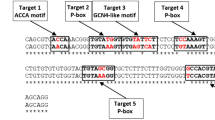Abstract
A total of 35 independent transgenic tobacco plants were produced using the Agrobacterium tumefaciens-leaf segment co-cultivation method followed by selection with kanamycin for the nptII gene. The vector also carried the tobacco feedback-insensitive anthranilate synthase gene (ASA2). Many of the lines showed increased ASA2 mRNA levels but only three contained increased free tryptophan (Trp) and many lines contained lower Trp than the untransformed control. The line with the highest Trp level (threefold that of the untransformed control) contained increased anthranilate synthase activity (AS) both in leaves and a cell suspension culture derived from the plant while the feedback insensitivity was most evident in the suspension culture. Other kinetic data also indicated that the ASA2 encoded AS α-subunit was more abundant in the tissue culture than in leaves. Progeny seedlings from this line were resistant to certain toxic Trp analogs, especially α-methyltryptophan (αMT) and less so to the most commonly used analog, 5-methyltryptophan. Shoots formed more readily from leaves of two of the transgenic lines than from leaves of the untransformed control on αMT, indicating that it might be possible to use ASA2 as a selectable marker gene and αMT as the selection agent.









Similar content being viewed by others
Abbreviations
- αMT:
-
α-Methyltryptophan
- AS:
-
Anthranilate synthase
- ASA2:
-
Feedback-insensitive anthranilate synthase
- 6-BA:
-
6-Benzyladenine
- Kan:
-
Kanamycin
- 5MT:
-
5-Methyltryptophan
- Trp:
-
Tryptophan
References
Anderson PC, Chomet PS, Griffor MC, Kriz AL (1997) Anthranilate synthase gene and its use thereof. World Intellectual Property Organization 97/26366. World Intellectual Property Organization
Bernasconi P, Walters EW, Woodworth AR, Siehl DL, Stone TE, Subramanian MW (1994) Functional expression of Arabidopsis thaliana anthranilate synthase subunit I in Escherichia coli. Plant Physiol 106:353–358
Bohlmann J, DeLuca V, Eilert U, Martin W (1995) Purification and cDNA cloning of anthranilate synthase from Ruta graveolens: modes of expression and properties of native and recombinant enzymes. Plant J 7:491–501
Bohlmann J, Lin T, Martin W, Eilert U (1996) Anthranilate synthase from Ruta graveolens duplicated ASα genes encode tryptophan-sensitive and tryptophan-insensitive isoenzymes specific to amino acid and alkaloid biosynthesis. Plant Physiol 111:507–514
Brotherton JE, Hauptmann RM, Widholm JM (1986) Anthranilate synthase forms in plants and cultured cells of Nicotiana tabacum L. Planta 168:214–221
Cho H-J, Brotherton JE, Song H-S, Widholm JM (2000) Increasing tryptophan synthesis in a forage legume Astragalus sinicus by expressing the tobacco feedback-insensitive anthranilate synthase (ASA2) gene. Plant Physiol 123:1069–1076
Cho H-J, Brotherton JE, Widholm JM (2004) Use of the tobacco feedback-insensitive anthranilate synthase gene (ASA2) as a selectable marker for legume hairy root transformation. Plant Cell Reports 23:104–113
Fisher DK, Guiltinan MJ (1995) Rapid, efficient production of homozygous transgenic tobacco plants with Agrobacterium tumefaciens: a seed-to-seed protocol. Plant Mol Biol Rep 13:278–289
Gillott MA, Erdos G, Buetow DE (1991) Light-induced chloroplast differentiation in soybean cells in suspension culture: ultrastructural changes during the bleaching and greening cycles. Plant Physiol 96:962–970
Haslam E (1993) Shikimic acid: metabolism and metabolites. Wiley, Chichester
Kreps JA, Town CD (1992) Isolation and characterization of a mutant of Arabidopsis thaliana resistant to alpha methyltryptophan. Plant Physiol 99:269–275
Murashige T, Skoog F (1962) A revised medium for rapid growth and bioassays with tobacco tissue cultures. Physiol Plant 15:473–497
Murray MG, Thompson WF (1980) Rapid isolation of high molecular weight plant DNA. Nucleic Acids Res 8:4321–4325
Radwanski ER, Last RL (1995) Tryptophan biosynthesis and metabolism: biochemical and molecular genetics. Plant Cell 7:921–934
Ranch JP, Rick S, Brotherton JE, Widholm JM (1983) Expression of 5-methyltryptophan resistance in plants regenerated from resistant cell lines of Datura innoxia. Plant Physiol 71:136–140
Song H-S, Brotherton JE, Gonzales RA, Widholm JM (1998) Tissue culture-specific expression of a naturally occurring tobacco feedback-insensitive anthranilate synthase. Plant Physiol 117:533–543
Tsai F-Y (2002) The overexpression of a feedback-insensitive anthranilate synthase in Arabidopsis and tobacco. PhD thesis. University of Illinois, Urbana-Champaign, Ill.
Wakasa K, Widholm JM (1987) A 5-methyltryptophan resistant rice mutant, MTR1, selected in tissue culture. Theor Appl Genet 74:49–54
Widholm JM (1972) Cultured Nicotiana tabacum cells with an altered anthranilate synthase which is less sensitive to feedback inhibition. Biochim Biophys Acta 261:52–58
Zhang X-H, Brotherton JE, Widholm JM, Portis AR (2001) Targeting a nuclear anthranilate synthase α-subunit gene to the tobacco plastid genome results in enhanced tryptophan biosynthesis. Return of a gene to its pre-endosymbiotic origin. Plant Physiol 127:131–141
Acknowledgements
We thank Dr Hyeon-Je Cho for the C2ASA2 plasmid. Financial support was provided by the Consortium for Plant Biotechnological Research, the State of Illinois through the Illinois Council on Food and Agricultural Research and the Illinois Agricultural Experiment Station.
Author information
Authors and Affiliations
Corresponding author
Additional information
Communicated by G.C. Phillips
Rights and permissions
About this article
Cite this article
Tsai, FY., Brotherton, J.E. & Widholm, J.M. Overexpression of the feedback-insensitive anthranilate synthase gene in tobacco causes tryptophan accumulation. Plant Cell Rep 23, 548–556 (2005). https://doi.org/10.1007/s00299-004-0849-0
Received:
Revised:
Accepted:
Published:
Issue Date:
DOI: https://doi.org/10.1007/s00299-004-0849-0




